Lifestyle
The Best Garden Color Schemes To Boost Your Curb Appeal

One of the simplest joys in my life right now is walking through my neighborhood and admiring my neighbors’ hydrangea bushes. Not every house has them, but the ones that do exude effortless beauty. They’re a burst of pink or blue blooms that I’m savoring, since I know hydrangea season doesn’t last forever. They remind me that color makes an incredible impact, especially when it’s part of a garden in front of your home. The lush pink blooms are friendly and inviting. They emit an air of playfulness, while the deep blue hydrangea bushes seem more peaceful and grounded in their beauty. Garden color schemes clearly set the mood for your outdoor living spaces, and it’s a step you don’t want to skip when planning your garden.
If you’d like to plant a garden but aren’t sure where to begin, I chatted with mother-daughter duo Brooke and Leila Giannetti, garden designers at Patina Meadow, as well as Madeline Hooper, host of the PBS TV show Garden Fit, to get their pro tips on all things garden color schemes. Ahead, learn how to design your garden with color in mind, as well as the best color schemes to try yourself!

Where to Begin When Planning Your Garden
Before you head to the nursery, both Giannetti’s suggest taking time to think about the mood you want to set, as well as the intention you have for your outdoor space and garden. “Are you looking to grow food for your family? Are you trying to create a space mostly for visual interest? Either way, there are a few design tips to keep in mind,” the duo suggests.
Just like you would an interior space, they encourage using hedges and trees to enclose spaces, like an outdoor room. “This creates a sense of intimacy and privacy, almost like different rooms in a house.” As far as picking which plants and flowers are right for your garden, Hooper says to lead with your heart and to not think too hard about what’s right or wrong. “Surround yourself with colors you love,” she says. “Allow yourself to react to what surprises you and delights you about a garden.”
Hooper also suggests noticing what plants and flowers are working for your neighbors—that means the conditions you both share work well! And finally, if you’re feeling nervous as a beginner gardener, Hooper encourages taking some pressure off and to have fun. “It truly doesn’t matter how you start. You make mistakes. Plants die. You learn by trial and error!” she exclaims.
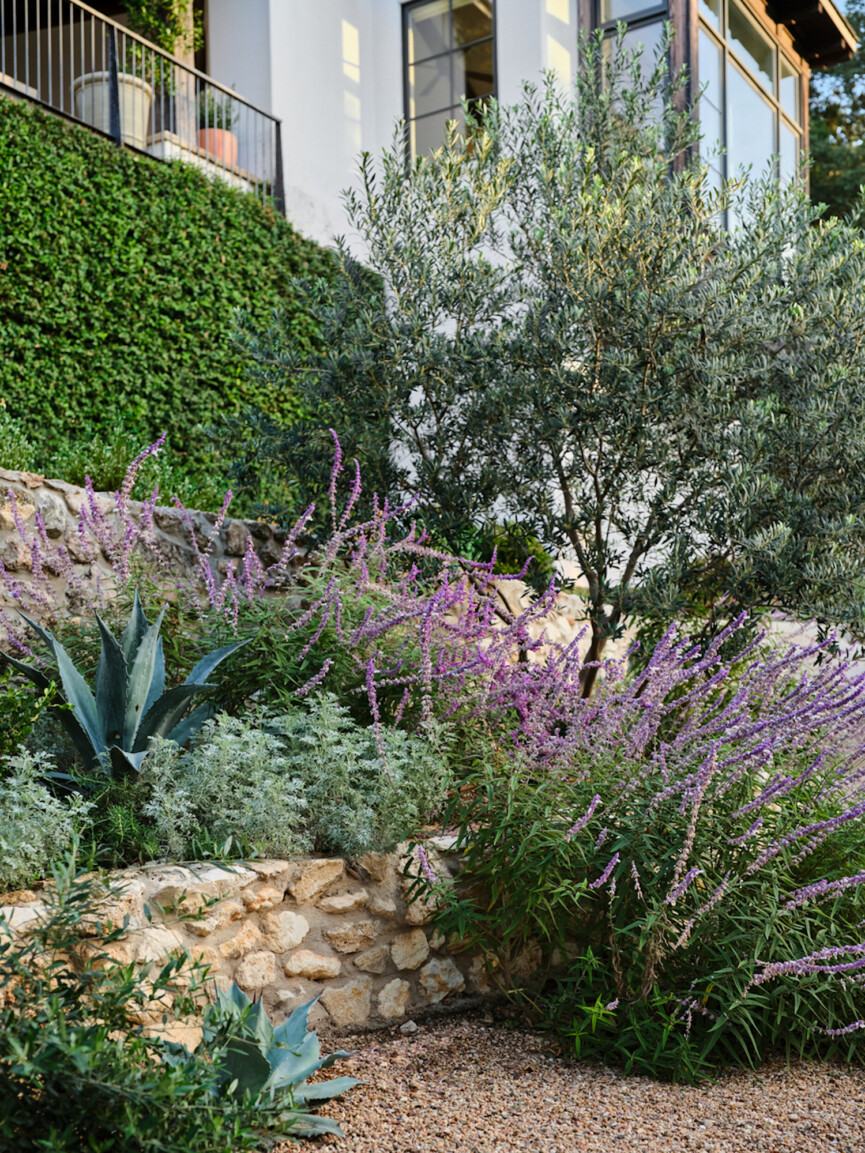
Why a Color Palette Is Important
“A garden color scheme provides unity and coherence in garden design. It ensures that all elements work together harmoniously, creating a space that is not only visually appealing, but also emotionally resonant,” the Giannetti’s share. “A cohesive color palette helps avoid visual clutter and creates a sense of calm and order, which is particularly important in a garden meant for relaxation and enjoyment.”
If you’re not sure what colors look best together, or just feel afraid to commit, Hooper suggests pots to start. “You don’t have to make the commitment to dig them into the ground necessarily,” she remarks. Knowing what colors and flowers you’re drawn to—as well as the ambience you’d like your outdoor space to have—will set the tone for creating the garden of your dreams.
“Ultimately, your garden should reflect your tastes and preferences. Choose colors that make you happy and create a space where you love to spend time!” the Giannetti’s add.
Four Garden Color Schemes We Love
You can’t go wrong with the following garden color schemes, recommended by Hooper and the Giannetti’s. Ranging from sweet and soft to dramatic and bold, choose the garden color scheme that speaks to your heart—as well as the outdoor space you’re longing to create.
Soft Pastels
If you envision a garden fit for afternoon reading, morning meditation sessions, or casual dinner parties, a pastel color palette would be the dream. “We absolutely adore soft pastel palettes—light lavenders, pale pinks, and soft whites. This combination evokes feelings of calm, serenity, and soothing tranquility,” the Gianetti’s share. Hooper is also a fan of this color palette. “In my garden around the pool, I like to stick to cool pastel colors that go with the water color and gray stone coping,” she explains.
Hooper loves various shades of pinks, blues and yellows and shares that Achillea moonshine, Astilbe ‘Peach Blossom’ and Geranium Roxanne look better and better in her garden each year. Both Giannetti’s love mixing purple with pink or white. “For a soft pastel palette, we would use plants like lavender and thyme, which not only add beautiful pastel hues but also a wonderful scent,” they share. “Pair these with pink and white roses or hydrangeas. The key is to maintain a limited palette and focus on texture for added interest.”
Deep, Rich Hues
If you have an eye for the dramatic and want your home to pop, darker colors may be more your speed. The Giannetti’s recommend pairing deep, rich florals with lush greenery. “Dark tulips in spring, and rich purple hydrangeas in summer are excellent choices,” they advise. “Complement these with foliage plants like boxwoods and yews to add some structure, while complementing the color scheme. You could even add blackberry vines to add a functional touch of rich beauty!”
Blackberry vines will, of course, produce fruit and the berries will turn from a deep red to black as they ripen, naturally providing a beautifully rich color palette. Another option? Orange and yellow blossoms provide stark contrast to deep purple blooms, making purple and orange an unexpected, yet beautiful color scheme to try. Mix gold and orange avens (Geum spp.) or yellow Hollyhock Alcea ’Spotlight Sunshine’ with purple or crimson scabiosa (or pincushion flower) for a stunning jewel-toned garden.
Monochromatic
A garden color scheme doesn’t need to include multiple colors. In fact, going monochromatic and picking just one color is a fantastic choice, especially if you have a color you’re especially fond of. For Hooper, that color is red. “The dramatic effect of planting beds or borders of one color is also a fun challenge, and for years I have had a red color-themed bed that I adore,” she gushes. “It’s more upkeep because I have to replant Dahlias Bishop of Llandaff each season, but they look great with red peonies, Dianthus Telstar Scarlet, and Echinacia purpurea ‘Sombrero Salsa Red’.”
“Combining different blooms in similar colors—like light lavenders from herb plants such as lavender and thyme, with pink and white rose varieties or hydrangeas—adds depth and variety without overwhelming the senses,” the Giannetti’s note. As with any garden color scheme, decide on the mood you want to create for your garden, then choose your color accordingly. A blue garden with blue hydrangeas, Phlox paniculata ‘Blue Boy’ or Delphinium ‘Million Dollar Blue’ will be calm and serene. A yellow garden with Alchemilla mollis or Baptisia ‘Caroline Moonlight’ will be bright and cheerful.
Keep in mind that a monochromatic garden can include various shades of the same hue, so don’t be afraid to plan your purple garden with pale lavenders as well as deep purples that almost read black. “Even with a limited color palette, you can create a lot of visual interest through texture,” the Giannetti’s add.
Rewilding
If you’re interested in a maximalist color palette where anything goes, rewilding is a garden trend you’ll love. Also referred to as meadowscaping, this garden trend relies on native grasses and wildflowers being allowed to grow freely.
“This idea of garden chaos being positive is a big deal,” Hooper remarks. “If you want different colors, you can do that, and it looks smashing.” If you have dreams of running through your own wildflower meadow, see what many would typically consider weeds in a new light. “Whatever seeds are in the soil—let them grow,” Hooper suggests. “Then keep what you like, and pull out what you don’t like.”
You can learn what is native to your area by doing a quick search through the National Audubon Society. From there, notice what colors and plants you’re drawn to. Because rewilding is in fact a bit wild, your color palette can remain simple if that’s more your vibe. Stick with a monochromatic palette and choose flowers in the same shade, or select up to four different hues for a multi-color meadowscape.
Lifestyle
The Best White Curtains, According to Interior Designers

Finding the best white curtains for a space is easier said than done. It involves navigating a sea of inconspicuously named shades of white (think: ivory, bone, pure white, off-white), considering weight (how sheer is too sheer?), and selecting a perfect length that hits a Goldilocks ideal of being both not too short, but also not too long.
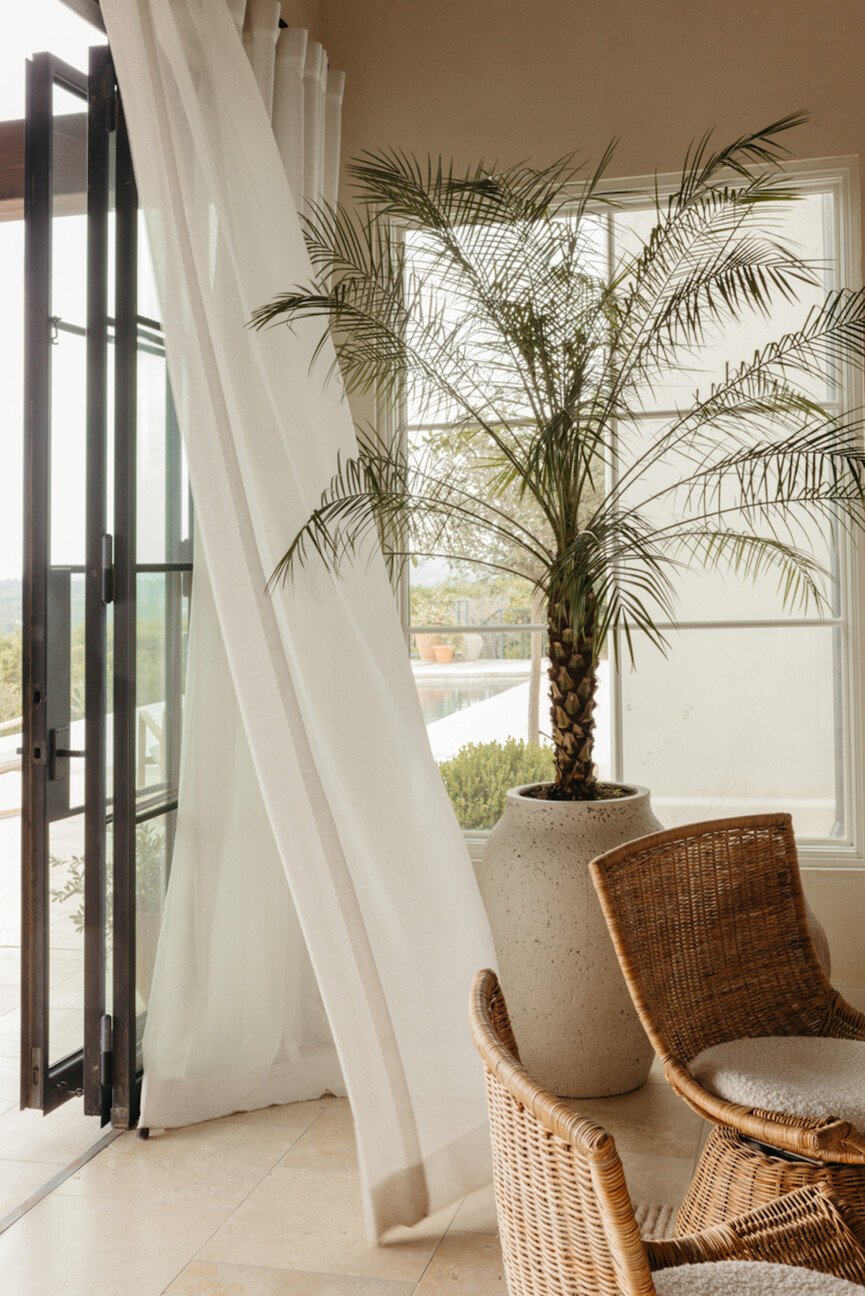
The Best White Curtains, According to Designers
The stakes for getting it right are surprisingly high. The ideal white curtains will make your space feel bright and inviting versus smaller and darker than it actually is. To help narrow the search, we asked some of our favorite interior designers to tell us which white curtains they buy over and over again. And they did not disappoint.
Keep scrolling to find out which white curtains get the pros’ stamp of approval.

Restoration Hardware Italian Textured Weave Drapes in White
Los Angeles-based interior designer Kerry Vasquez swears by pleated white curtains from Restoration Hardware. “The quality is top-notch, the weight of the curtain is sumptuous, and the way the curtain falls is just right,” she explains.
“I am a big fan of contrast, so when hanging white curtains I usually opt for black wrought iron hardware like the Antique Bronze Hardware Collection at Pottery Barn,” she adds. “I am also a fan of hanging curtain rods closer to the ceiling than the window if space permits!”
One mistake Vasquez sees too often is people buying curtains in the wrong size. “Many times, clients end up getting curtains that are too small and make the room and windows appear smaller than they actually are,” the designer explains. When in doubt, opt for the longer version.

If you’re ready to ditch those IKEA curtains you’ve had forever, Shaun Crha, principal designer and founder of Wrested Interiors, recommends opting for custom drapes. “Everhem is fantastic for upgrading from the big box store curtains since they make it so easy to get all the measurements and proportions right,” he says. “My go-to is their bone fabric with a pinch pleat.”
According to Crha, one add-on is 100% worth the extra money. “I always recommend getting lined panels if you want them to last longer because exposure to UV light really takes a toll on fabric,” advises the designer. Especially if you’re hanging curtains in a sun-drenched dining room, like the one pictured here, or a living room that gets an exceptional amount of light.
Hot tip: If you’re hanging curtains in your bedroom, Crha recommends a tried-and-true installation technique. “Try a French return rod if you like a classic look and you want to stop that stream of light from hitting you in the face when you want to sleep in,” he says.
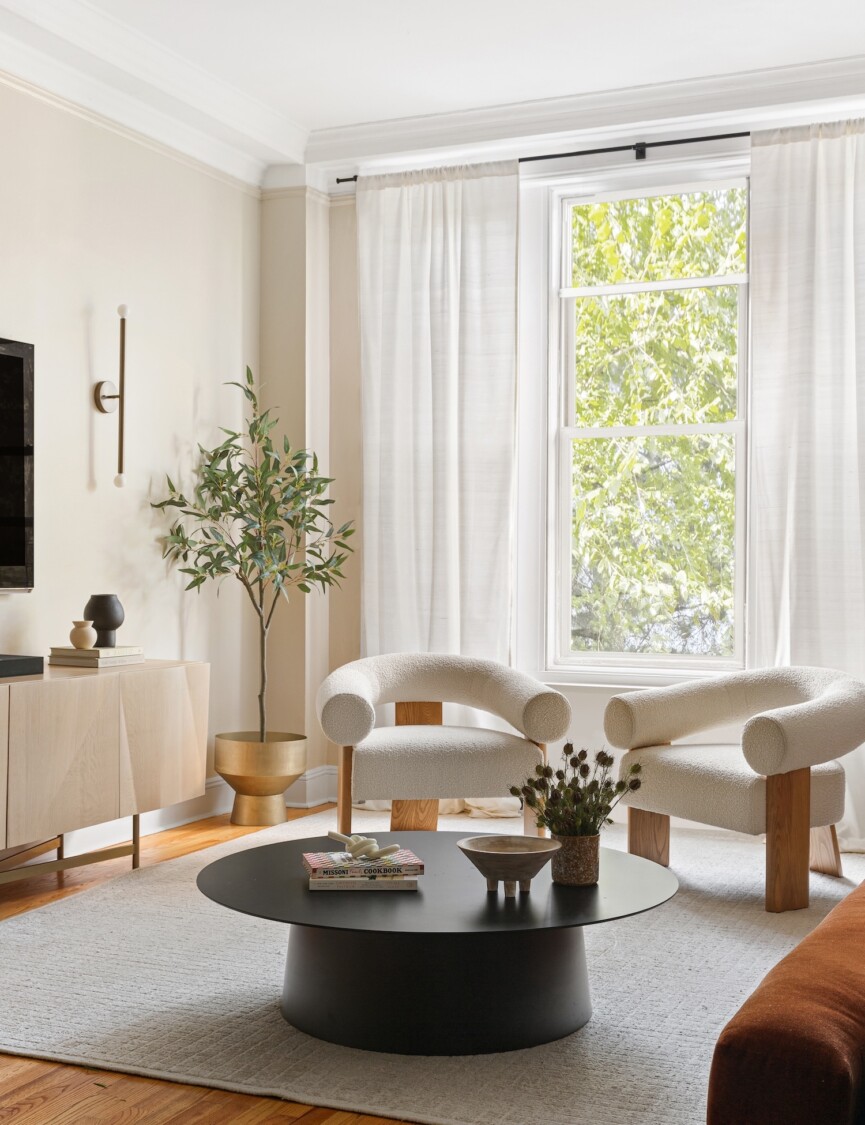
Pottery Barn Custom Emery Linen Curtain in Ivory
Designer Isabella Patrick recently purchased these ivory curtains for a client who didn’t want to spend a ton on custom shades for her rental apartment. When it comes to selecting the right white curtains, Patrick recommends considering the undertones of the shade and keeping your space’s entire color palette top of mind. “This Pottery Barn option—when properly installed and styled—lifts up the room and lends to the whole upscale and warm vibe,” she tells us.
So, how do you properly install curtains? “A good rule for hanging is to install the hardware wider than the frame of the window, and don’t be afraid to go way beyond the window frame to create the illusion of a bigger window,” explains the designer. “The same goes for hanging height. You can go a few inches—or more—above your window frame to create that larger window illusion, but also to offset a ready-made curtain length that may be too long.”
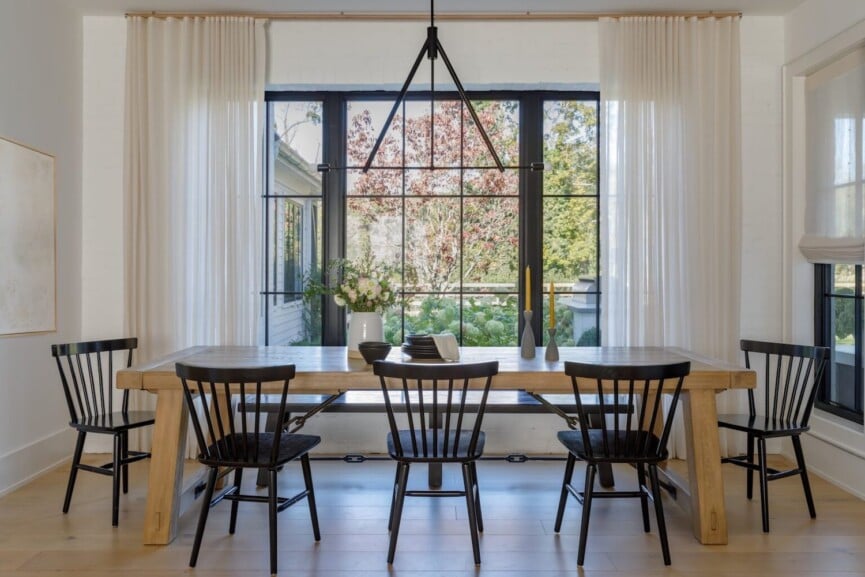
The Shade Store Ripple Fold Drapery in White Linen
New York-based interior designer Becky Shea is partial to white linen curtains from The Shade Store. But in a very particular style. “My absolute favorite drapery style, without a doubt, is the ripple fold drape,” reveals Shea. “The cascading folds of a ripple fold drape embody timeless, quiet luxury.”
She also advises hanging curtains so they create a ¼-inch puddle on the floor. “It lends the drapery a more sophisticated look and feel,” she explains. “My biggest no-no is hanging drapery at the trim of a window or above the floor—never, ever do this. At a minimum, the drapery should kiss the floor, and ideally, it should puddle ever so slightly.”
Threshold™ Light Filtering Farrah Window Curtain Panel
“I’ve purchased an embarrassing amount of curtains over the years in my quest to find the perfect style, and I think I finally found ‘the one,’” says Carrie Waller of her go-to white curtains. One major selling point for Waller is that they’re sheer, but not too sheer. “These lightweight curtain panels look opaque but allow just the right amount of light to filter beautifully through,” the founder of Dream Green DIY explains.
Lifestyle
8 Probiotic Foods for a Healthier Gut, According to a Nutritionist

Let’s cut right to the chase: if you want a healthy gut, you need probiotics. These tiny (but mighty) beneficial bacteria are the unsung heroes of digestion. They work around the clock to keep your digestive system balanced and operating smoothly. Without ’em, bloating runs rampant. Probiotics are also key for all things nutrient absorption. What’s the best way to maintain these gut-friendly powerhouses? Through probiotic foods. Get the rundown on all things probiotics, including the best natural sources to add to your diet.

Yes, Your Gut Health Matters
It bears repeating: gut health is fundamental to our overall well-being. Our digestive system—home to trillions of microorganisms—keeps our body humming along. If we can’t properly digest and assimilate our food, our organs don’t function. On the flip side, maintaining a healthy gut (via a balanced diet, probiotic foods, and lifestyle choices) can be the difference between robust health and a slew of chronic illnesses. By supporting your gut, you’re also taking care of your mental well-being, immunity, and more.
What are probiotics?
Speaking of supporting your gut, let’s talk about probiotics. After all, the digestive process wouldn’t function without them. Often referred to as “good” or “friendly” bacteria, probiotics help keep our gut healthy. And this is essential for digestion, cognitive function, nutrient absorption, and immune defense. Remarkably powerful, this complex community of microbes resides (naturally) in the body, but we also absorb probiotics from what we eat.

Think of Your Gut as a Garden
Ultimately, probiotics play a critical role in maintaining gut equilibrium. They do this by preventing the overgrowth of harmful bacteria. If you think of your gut as a garden, probiotics are akin to helpful plants. They crowd out weeds (bad bacteria) while promoting a healthy environment. By eating foods rich in probiotics—yogurt, kefir, sauerkraut, etc.—you’re adding more of these good bacteria to your gut. And a well-balanced gut microbiome is truly life-changing. Sayonara, digestive disorders!
How do probiotics work?
They compete with not-so-good bacteria. Thanks to certain substances probiotics produce, they prevent pathogenic microorganisms from taking over. In turn, this creates digestive homeostasis. Additionally, probiotics are known to modulate the immune system. This enhances the body’s ability to swiftly respond to infections and reduce inflammation.
To summarize, there’s a dual action at play: probiotics balance the gut microbiome and boost immune function.

How many probiotics should you have every day—and can you overdose?
This varies. Your needs depend on the type (and strain) of probiotic, as well as any health conditions you have. But generally speaking, most health professionals recommend aiming for at least 1 billion CFUs per day.
Probiotic supplements and probiotic-rich foods contain between 1-10 billion colony-forming units (CFUs) per serving. To put that into perspective, kefir contains 15-20 billion CFUs and yogurt has about six billion CFUs. Overdosing isn’t typically something to worry about. It’s considered safe to consume high amounts of probiotics, especially when obtained from food sources.
However, excessively high doses of probiotic supplements can lead to minor side effects—i.e., gas, bloating, or an upset stomach. Fortunately, these side effects are usually temporary and can be mitigated by gradually increasing your probiotic intake. Chat with your healthcare professional before changing your probiotic routine.
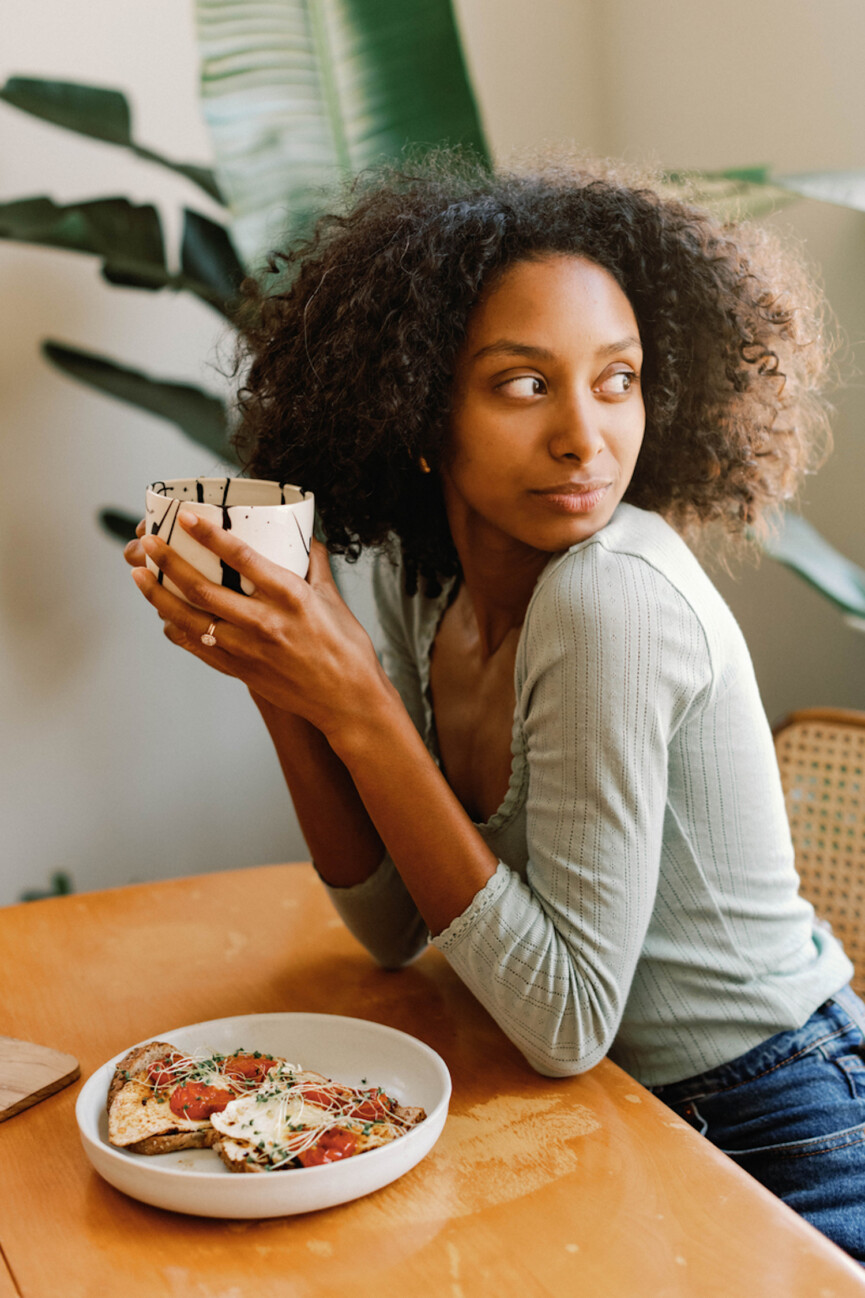
Probiotic Foods vs. Supplements
As mentioned, your daily dose of probiotics comes in two forms: probiotic-rich foods or dietary supplements. But is one a better bang for your buck? Or is a combo the way to go? Based on your dietary preferences, health needs, and lifestyle, the choice is yours. Here’s a breakdown of both:
Probiotic Foods
Benefits:
- Nutrient-rich. Probiotic foods (yogurt, kefir, sauerkraut, kimchi, miso, tempeh, etc.) do double duty. They’re rich in probiotics and provide essential nutrients—like vitamins, minerals, and fiber.
- Natural source. Compared to most supplements, probiotic-rich foods offer a natural and more diverse array of probiotic strains.
- Better absorption. Thanks to the presence of other nutrients, we can better absorb the probiotics we consume.
- Culinary variety. Incorporating probiotic foods (like this homemade yogurt!) is a delicious way to enhance your meals with different flavors and textures.
Drawbacks:
- Taste and preference. Certain probiotic foods have an acquired taste—they’re often tangy and tart.
- Consistency. Whether you travel often or aren’t able to cook a majority of your meals at home, it can be challenging to consume enough probiotic foods (in sufficient amounts) to achieve the desired health benefits.
- Dietary restrictions. If you have any dietary restrictions (i.e., lactose intolerance) it can be harder to include a wide variety of probiotic foods.
Probiotic Supplements
Benefits:
- Convenience. Probiotic supplements are easy to take and can be included in a daily routine— without the need to prep specific foods.
- Controlled dosage. Supplements offer a precise dosage of specific probiotic strains, making it a no-brainer to meet daily requirements.
- Variety of strains. High-quality supplements often contain a blend of multiple strains tailored for specific health benefits (like acne).
Drawbacks:
- Less nutritional value. Unlike probiotic foods, supplements don’t provide additional nutrients, therefore lacking the synergistic effects of food-based probiotics.
- Cost. Probiotic supplements can be expensive, especially high-quality supps with multiple strains and high CFU counts.
- Quality variation. The quality and efficacy of probiotic supplements vary widely between brands. Make sure you’re choosing reputable supplements!
Which are better?
For most of us, a combination of both is the best approach. That way, you can enjoy the nutritional benefits of probiotic foods while using supplements to meet specific health needs (or ensure consistent intake). Of course, if you prefer a more holistic approach, skip the supplements and incorporate as many probiotic foods into your diet that you can. But for sake of convenience—and tailored health goals—consider a probiotic supplement with targeted strains.

8 Probiotic Foods to Include in Your Diet
With an emphasis on using food as medicine, below are popular probiotic foods to use as the base of your meals (or add on the side).
1. Yogurt
One of the most popular foods with probiotics, yogurt is made by fermenting milk with live bacterial cultures. When grocery shopping, opt for plain organic or pasture-raised yogurt. If you don’t respond well to dairy, try A2 yogurt (it’s easier to digest), goat’s milk yogurt (for those sensitive to cow’s milk), or unsweetened coconut yogurt.
Try this: Homemade yogurt and 19 protein-packed Greek yogurt recipes.
2. Kefir
New to kefir? Similar to yogurt, it’s a fermented drink with a thinner consistency. Fun fact, kefir has more probiotics than yogurt and a more diverse range of bacteria and yeasts. Additionally, it’s lactose-friendly. The fermentation process breaks down most of the lactose, which is ideal if you’re lactose intolerant.
Try this: You can sip kefir on its own, toss it into smoothies, or use it as the base for salad dressings.
3. Sauerkraut
Made by fermenting finely chopped cabbage with lactic acid bacteria, sauerkraut is a house fave. It dates back over 2,000 years—to ancient China—where it was originally made with rice wine. While it’s a rich source of probiotics, it also provides a boost of vitamin C. Low in calories but high in fiber, sauerkraut is a healthy and satisfying addition to a variety of savory meals.
Try this: We love topping nourish bowls or layering sandwiches with a healthy spoonful of sauerkraut.
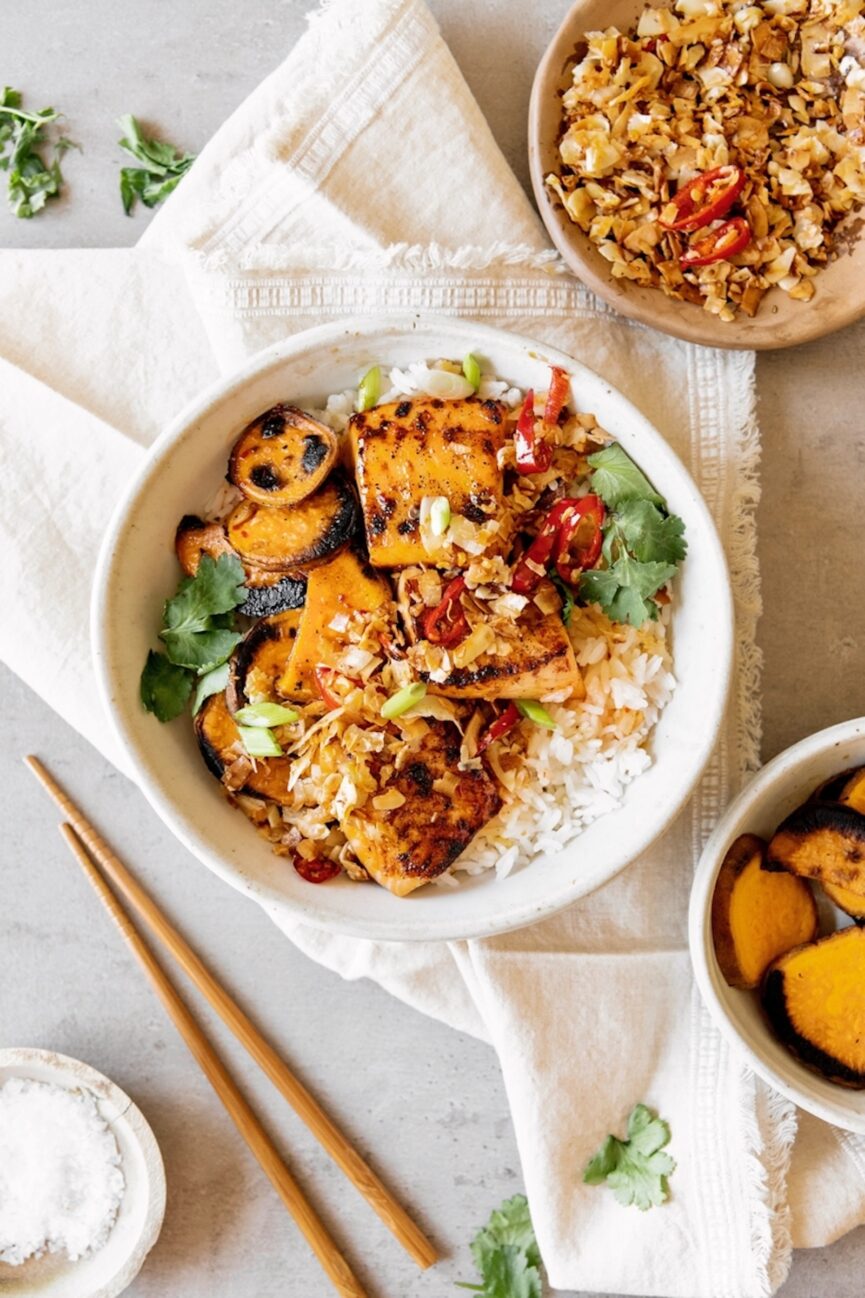
4. Kimchi
Kimchi is another favorite. This traditional Korean dish is made by seasoning and fermenting vegetables (primarily, cabbage and radishes) with chili pepper, garlic, ginger, and other spices.
Try this: Serve it as a side, add it to your favorite rice dish, or use kimchi as a flavor-packed condiment.
5. Miso
Known for its savory umami taste, miso adds depth and richness to soups, marinades, and dressings. Beyond its incredible flavor, miso (Japanese fermented soybean paste) supports digestive health and adds antioxidants to your meals. Miso comes in various types—white, yellow, red—and can be used in both traditional and modern recipes.
Try this: A 30-minute miso pasta recipe is a weeknight, probiotic-rich staple.
6. Pickles (Fermented)
If you think all pickles are created equal, think again. There are actually four distinct types of pickles, each with their own unique flavor and texture—and more importantly, different health benefits. To keep things simple, avoid shelf-stable neon yellow pickles (those that contain Yellow Dye 5—yikes!) which do nothing for gut health. Instead, choose fermented dill pickles. These are made with salt and not vinegar and have a complex umami flavor. This fermentation process means you’re noshing on gut healthy, microbiome-boosting pickles.
Try this: We love pickles as a crunchy snack, but you can also use them to bring texture and punchy flavor to your favorite savory mains.
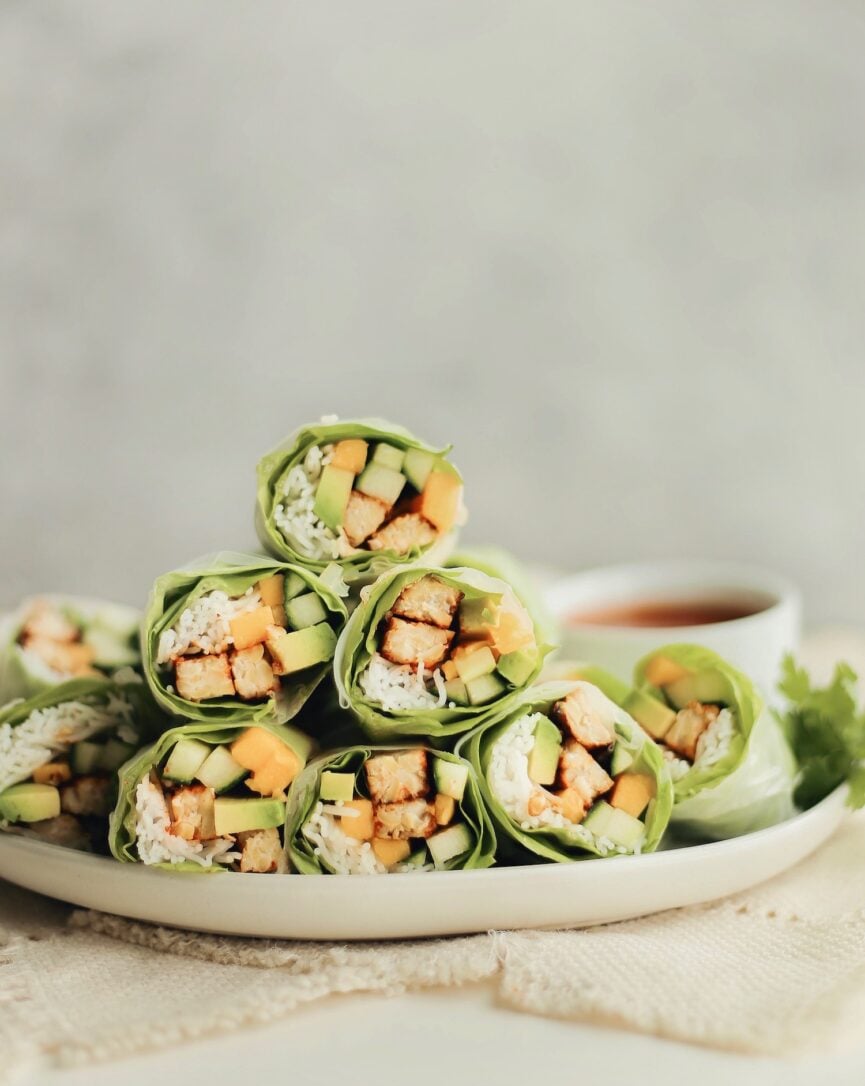
7. Tempeh
Another fermented soybean product, tempeh has a firm texture and nutty flavor. It’s high in plant-based protein, vitamins, and minerals and supports gut health. You can grill it, stir-fry it, or use tempeh in sandwiches, bowls, and salads. It can even be crumbled to mimic ground beef.
Try this: Honey Sriracha Tempeh Spring Rolls make for a quick and satisfying summer lunch.
8. Buttermilk
Last but not least, buttermilk. Traditional buttermilk is rich in probiotics and is lactose-friendly. It provides essential nutrients—like calcium, vitamin B12, and potassium—and it’s a true culinary delight.
Try this: Buttermilk’s flavor enhances baked goods, marinades, and dressings, adding a probiotic boost to your dishes (and smoothies!).
Lifestyle
Our Editors’ Top Desert Island Beauty Products to Stock up On

When I joined the Camille Styles team (officially full-time this month!), I knew I’d be surrounded by inspiring women. What I didn’t expect was that I’d join a team of beauty experts in their own right. So when I recently decided to overhaul my beauty routine, I naturally turned to Slack: “Help a girl out—drop your must-have beauty products!” Thirty minutes (and too many messages to count) later, my cart was full of tried-and-true products based on years of use—and of course, the most emphatic recommendations.
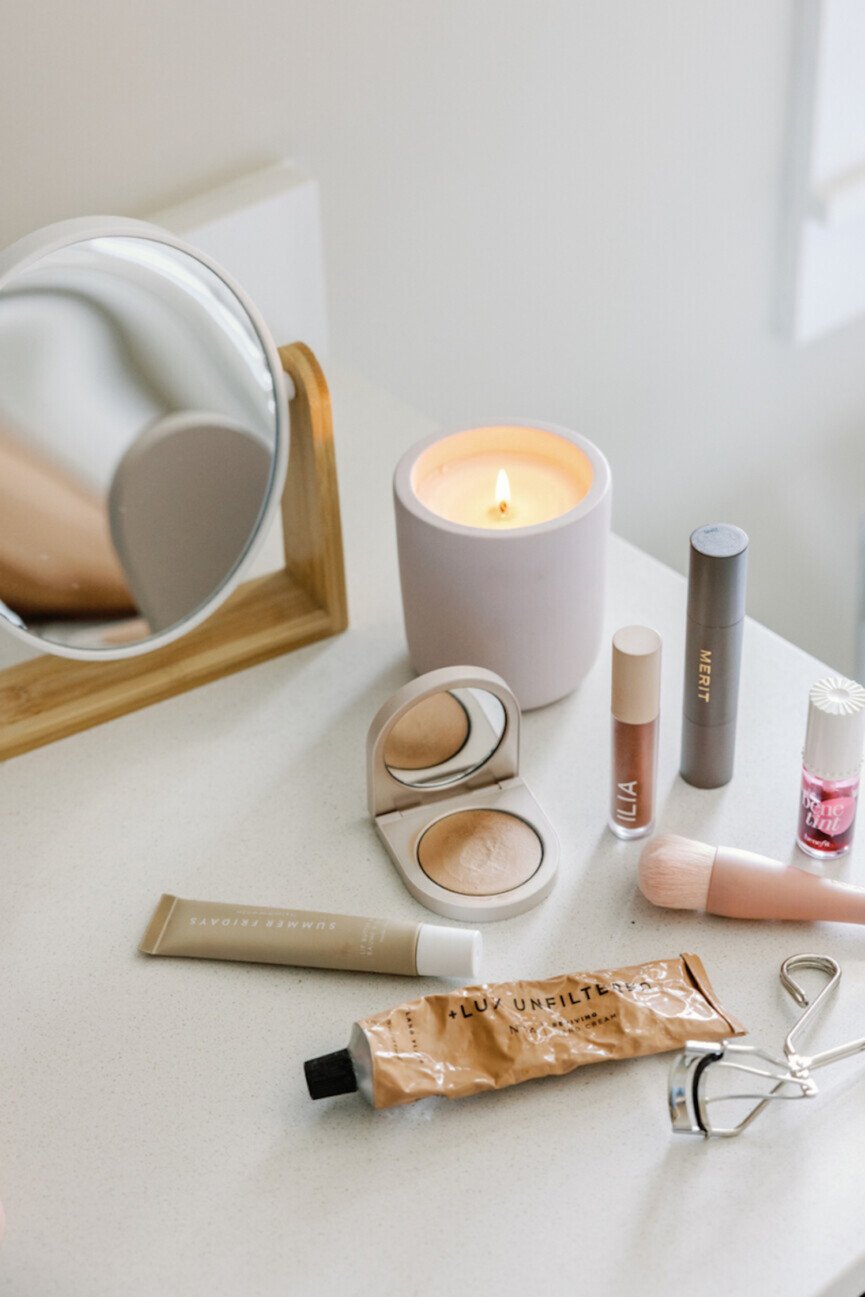
Our Editors’ 23 Must-Have Beauty Products to Stock Up On
After culling my co-workers’ top picks, my beauty bag is filled with sunscreen that doubles as my foundation while giving me an effortless glow, a lip and cheek stain that seamlessly transitions from day to night, and a lip balm that never leaves my side. These products have completely transformed my beauty routine. Now, I’m asking the inevitable: can I bring my entire makeup bag to the island?
Because we don’t gate-keep around here, I’m dropping every editor’s must-have desert island product in the list below. Whether you find yourself stranded on a desert island this summer (best of luck) or curating a beauty routine refresh, look no further. Consider this your insider scoop on all the beauty products our team can’t live without.
Makeup
Wander Beauty Mile High Club™ Length and Define Mascara
“Finally: I’ve found the best lengthening, volumizing, and defining mascara that doesn’t leave my lashes clumpy. It’s waterproof but easy to take off at the end of the day. With just a couple of swipes, my lashes are equally lengthened and give that flirty, doe-eyed look that I’m 100% obsessed with.” — Isabelle, Managing Editor
19/99 Precision Color Pencil
“Maybe controversial these days, but I’ll never give up on lining my lower eyelid! I started tightlining for a night out during the peak 90s grunge revival/indie sleaze era in high school and I’ve never given it up. I’ve gone through many an eyeliner pencil, and when you’re lining that close to your eye, you need something that glides across your lid. I’ve never used anything as effective or smooth in just one swipe than this 19/99 color pencil.” — Langa Chinyoka, Beauty Editor
Glo Skin Beauty Oil Free Tinted Primer
“Any good desert island product needs to be a multitasker—and this primer is the ultimate. It gives a lightweight coverage with a blurring effect to hide pores, nourishing skincare ingredients, plus SPF 30. I wear it on its own to work out in the morning, then layer my makeup on top during the day. Color-correcting, evening out skin tone and texture, and boosting your makeup’s wear-time—it truly does it all!” — Camille Styles, Editor-in-Chief
City Lips Plumping Lip Gloss
“I had ditched lip glosses long ago, not loving how sticky and too high-shine the majority were. But this gloss offers the perfect amount of moisture for a dewy pout. What’s more, not only does it look good, but it also offers a dramatic plumping effect immediately and then gradually builds over time. Formulated with hyaluronic acid and oligopeptides, it volumizes lips while offering major hydration.” — Isabelle, Managing Editor
MERIT Minimalist Perfecting Complexion Foundation and Concealer Stick
“As someone who has previously opted for more full-coverage makeup, I haven’t worn foundation in all of 2024, thanks to MERIT Beauty’s Perfecting Stick. Marketed as not a foundation and not a concealer, this one product has replaced both in my makeup bag. I apply it under my eyes, on any blemishes, and on my high points, then blend with a brush for an even, lightweight base.” — Bridget Chambers, Style Editor
ILIA Super Serum Skin Tint SPF 40 Skincare Foundation
“This is hands down the best tinted moisturizer I’ve ever used. The formula is filled with good-for-your-skin ingredients like niacinamide and hyaluronic acid, so it’s a beauty buy that doubles as a skincare product. Plus, it’s ideal for getting that dewy and glazed donut-y look.” — Megan Beauchamp, Contributing Editor
Westman Atelier Baby Cheeks Lip + Cheek Cream Blush Stick
“Blush is by far my favorite part of my makeup routine. I’ve perfected the ultimate three-step blush application that keeps its color and glow all day and night. The base? Westman Atelier’s blush stick in Petal. The non-toxic, creamy formula coupled with the prettiest rose-y color makes this product worth every penny. Steps two and three involve setting the cream blush with a powder blush, and topping it all off with an honorable mention, Charlotte Tilbury’s Highlighter Wand in Pinkgasm.” — Bridget Chambers, Style Editor
ILIA Limitless Lash Mascara
“It’s everything you want from a mascara: elongates lashes, doesn’t pill or smudge, and—most importantly—washes off easily. You normally get one or two but not all three. I don’t know how they do it, but I’ve been wearing this mascara for 3+ years and it’s my forever go-to.” — Brittany Chatburn, Content Marketing Director
Kulfi Beauty Kajal Eyeliner in Rain Check
“As someone who rarely wears makeup, it probably seems interesting that my choice for a desert island would be blue eyeliner. But on days when I just need to infuse my look with a little pop and joy, this eyeliner works its magic. I use a very thin line of blue eyeliner, but it’s just enough that when I’m talking to people while wearing it, they almost always have to stop and call out how much they love the blue. It’s the perfect way to subtly elevate your eyes, and the formula is super creamy and easy enough for even me to apply.” — Suruchi Avasthi, Food Editor
Jones Road Miracle Balm
“The Jones Road Miracle Balm is a game-changer for anyone seeking a no-makeup makeup look. It is ultra-moisturizing on the face and gives an effortlessly natural look with a dewy, radiant finish. Apply it with your fingers or a brush, which makes it the perfect low-maintenance desert island product. The balm is incredibly easy to use and buildable. It’s the perfect hero product for minimalist beauty routines.” — Brandy Joy Smith, Motherhood Contributor
Chanel Le Rouge Duo Ultra Tenue
“There is no better lip stain on the market and I will die on that hill. I’ve been using this product for YEARS. My favorite colors are Bright Raspberry, Strawberry Red, and Soft Rose, but you can’t go wrong on any to your liking. The stain stays on ALL day and ALL night, isn’t drying with the gloss coating, and doesn’t transfer to your drinking glass or partner’s lips.” — Kelly Krause, Contributing Editor
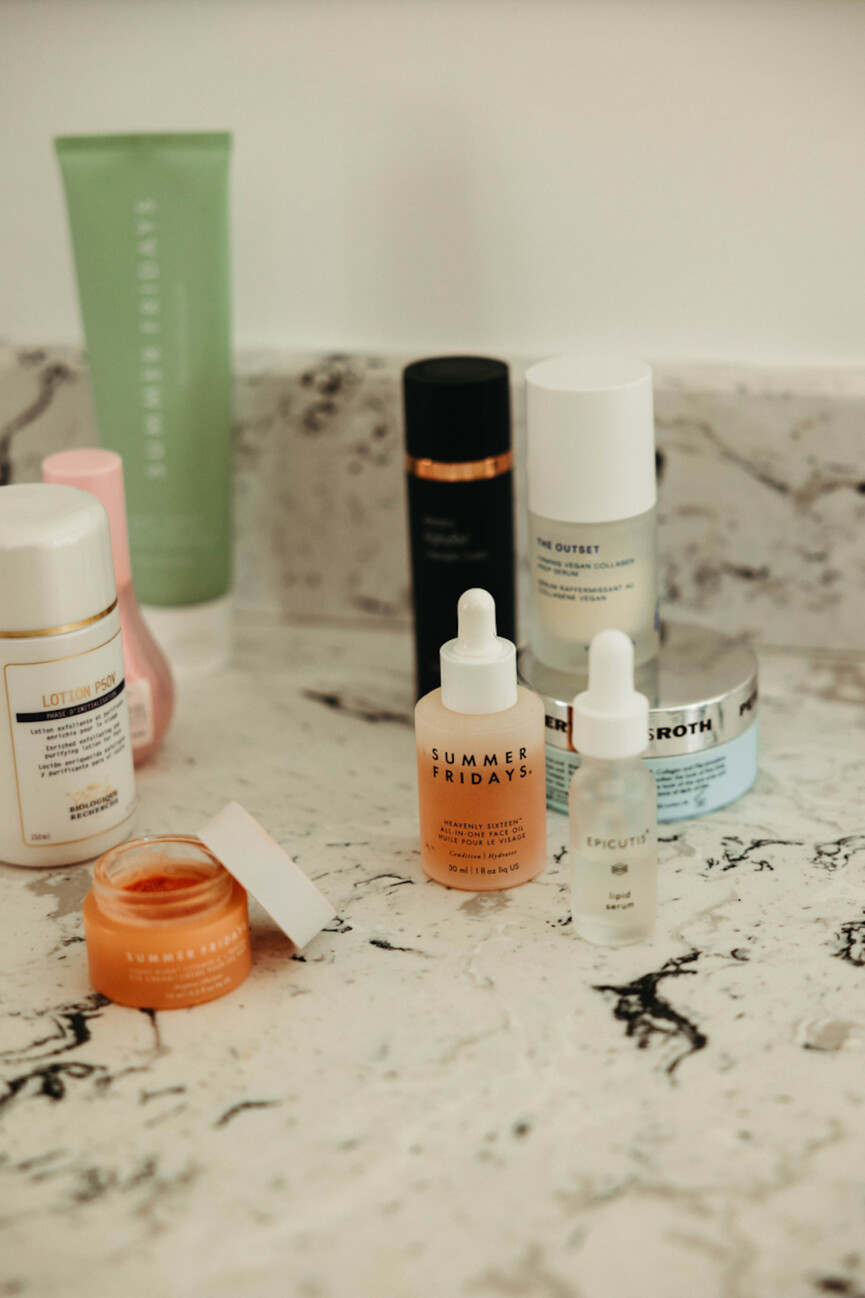
Skincare
Summer Fridays Lip Butter Balm
“The Summer Fridays Lip Butter Balm is nothing short of magic and would accompany me on a desert island or tropical getaway. Its buttery texture and long-lasting hydration make it the best product to always have on hand. I just repurchased it in Vanilla for the third time—it’s that good!” — Anna Decker, Social Media and E-Commerce Manager
Supergoop! Glowscreen in Golden Hour
“I am no one until I put on my Supergoop! Glowscreen in the morning. It quite literally brings me to life, adding the perfect amount of color and glow to my otherwise tired-looking face. I wear it alone on a day-to-day basis, but this sunscreen is also the perfect shimmery base for my makeup routine (even at night). Major props to Supergoop! for making sunscreen such an addicting part of my skincare/makeup routine. My skin will thank you in 20 years!” — Bridget Chambers, Style Editor
Laneige Lip Sleeping Mask
“Listen, I know this product had its moment in 2022. But there hasn’t been a night since I treated myself to this lip mask two years ago where I don’t put this stuff on before bed. Long story short, it’s my ride-or-die. My lips stay soft and hydrated year-round and I haven’t had chapped lips once, even in winter. My go-to is vanilla!” — Kristen Garaffo, Design Editor
Isle of Paradise Self Tanning Drops
“I live for a faux glow. A bit of self tan instantly boosts my confidence and I’ve tried everything from lotions to foams to water. Hands down, my favorite is Isle of Paradise Self Tanning Drops. A few drops in your moisturizer turns it into a self tanner, plus you can apply it without a mitt. It’s so easy and you can control how deep your tan is by the amount of drops you use. I love!” — Kristen Garaffo, Design Editor
Tower28 Beauty SOS Daily Rescue Facial Spray with Hypochlorous Acid
“This product changed my life, and I can’t stop talking about it to everyone. The start of my skincare routine, a top off when my skin is feeling irritated, and a preventive measure before applying makeup so I don’t break out—I use this multiple times a day, every day. If you haven’t heard of this universal healing spray, it’s quite literally magic in a bottle.” — Langa Chinyoka, Beauty Editor
SkinPharm Sheer Defense SPF
“When I first tried this SPF, I was in shock. A hydrating and tinted sunscreen? How? Diving in further, I saw that it contains hyaluronic acid. I love how lightweight and dewy my skin feels. If I’m on a deserted island, I’m going to need a good SPF that helps even out my skin tone for a flawless glow.” — Kelly Krause, Contributing Editor
Hero Cosmetics Rescue Balm + Red Correct
“I’ve been searching my entire life for a product like Hero Cosmetics’ Rescue Balm. As someone who suffers from rosacea, regular foundation doesn’t cut it when it comes to a flawless face. This is THE product for me—and it’s always the first product I reach for on no-make, makeup days. It goes on green, with the same consistency as a concealer, but blends effortlessly into the skin, combatting any redness. It’s lightweight, and can be applied under makeup or on its own. Simply put—I couldn’t live without it.” — Casey McKee, Editorial Intern
Dr. Loretta Intense Replenishing Serum
“This ceramide serum is my secret for putting on/taking off makeup. Layered beneath my makeup, it’s the perfect primer that creates a canvas to help my products stay on all night. I use a ton of liquid-based products, so a hydrated face is key to making sure they look dewy all night and don’t dry and crack in the middle of the dance floor. And after the night ends, when I’ve scrubbed my face raw to get off all the products, I need a hydrating serum to replenish my complexion so I wake up refreshed—even after a late night. This versatile serum is both. I also slather it on my skin when my barrier needs some TLC. It’s a staple in my travel bag since it can do it all.” — Langa Chinyoka, Beauty Editor
Bondi Sands Technocolor 1 Hour Express Self Tanning Foam
“My favorite self-tanning product, hands down. It’s foolproof to apply and the color develops within an hour. I use the one made for olive skin tones, and it gives the impression that you’ve just come back from an exotic two-week holiday.” — Camille Styles, Editor-in-Chief
Renee Rouleau Mint Renewal Cleanser
“I can’t stop talking about this product. I love it so much that my mom bought it for me when I went back to Nebraska to visit. The peppermint oil feels so refreshing and the light exfoliating jojoba beads keep my skin glowing.” — Kelly Krause, Contributing Editor
Soma Ayurvedic Jasmine Body Oil
“My favorite part of my self-care routine in the evening is using body oil after a hot shower. This oil has the most incredible scent, and seamlessly absorbs into your skin, leaving it soft and hydrated. Plus, this oil makes for the most perfect, self-care moment to just pause and breathe. It’s definitely a little bit of a splurge, but it’s well worth it for how amazing it makes me feel.” — Suruchi Avasthi, Food Editor
DERMAFLASH LUXE+ Advanced Sonic Dermaplaning + Peach Fuzz Removal
“My favorite self-tanning product, hands down. It’s foolproof to apply and the color develops within an hour. I use the one made for olive skin tones, and it gives the impression that you’ve just come back from an exotic two-week holiday.” — Camille Styles, Editor-in-Chief
-

 African History4 years ago
African History4 years agoA Closer Look: Afro-Mexicans 🇲🇽
-

 African History5 months ago
African History5 months agoBlack History Facts I had to Learn on My Own pt.6 📜
-

 African History4 years ago
African History4 years agoA Closer Look: Afro-Mexicans 🇲🇽
-

 African History1 year ago
African History1 year agoMajor African Tribes taken away during the Atlantic Slave Trade🌍 #slavetrade #africanamericanhistory
-

 African History4 months ago
African History4 months agoMr Incredible Becoming Canny/Uncanny Mapping (You live in Paraguay 🇵🇾)
-

 African History1 year ago
African History1 year agoCameroon 🇨🇲 World Cup History (1962-2022) #football #realmadrid #shorts
-

 African History1 year ago
African History1 year agoPROOF AFRICAN AMERICANS AIN'T FROM AFRICA DOCUMENTED EVIDENCE
-

 African History5 months ago
African History5 months agoBlack History Inventors: Mary Kenner 🩸
























